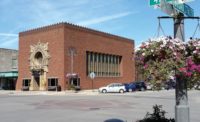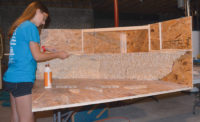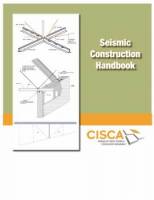The Guinness World Record for the longest echo in a man-made structure was recently awarded to the World War II-era underground oil tanks in Inchindown, Scotland. In January, acoustics explorer Trevor Cox rode a backboard through a 24-inch cleanout pipe into the tanks to make the winning measurements. Each tank is approximately 240 meters long, 9 meters wide and 13 meters high, and is dug out of solid rock and lined with concrete. With the tank surfaces still seeping fuel oil, Cox fired his starter pistol (Did you really think this through, Doc?) and recorded the echo, which lasts almost a full two minutes! The recordings stop at 80 seconds, but the standard measure of reverberation, RT60 (the time to drop 60dB), is extrapolated from them to be 112 seconds at 125 Hz.
Those who would like to hear this phenomenon without being shoved into an oily old tank can listen to Cox’s shared recordings at www.freesound.org/people/acs272/packs/13598. His measurements demonstrate a reverberation which is near the theoretical limit of what is possible. I wouldn’t have believed it, but you really can hear the shot for a full 80 seconds (listen for the “heartbeat” of the sound produced by the 0.7-second longitudinal mode travel time). It’s amazing to realize that at the end of the recording you’re listening to sound that has traveled over 28 kilometers (17 miles).
The Competition
In the world of car audio, United States Autosound Competition International competitions occur in cities around the planet, nearly every week of the year. Crowds are drawn to the spectacle of contestants’ highly modified vehicles equipped with high-powered audio systems which typically produce sound levels of 160 to 180 decibels—loud enough to blow out door seals, pop body rivets and shatter windshields.
Every June, amateur radio operators around the world participate in a 24-hour “field day,” setting up emergency-powered radio stations in primitive surroundings. Camps compete to be first with the greatest number of accurate communications with other stations.
Longest echo, loudest sound and greatest number of accurate communications: Why are those important? They’re not, except for the fact that those are the measures which determine the winners of these three particular contests.
Our buildings also are judged by the length of their reverberation, their noise levels and their ability to support speech communication, but the winners definitely aren’t at the extremes of the measurements we use to gauge them. The best building spaces measure somewhere in the middle on these scales. In this “Bizzarro World”-type “contest to finish somewhere in the middle,” winners generally go unnoticed by the crowds, and only the losers (those in the very front and in the very rear) are obvious to everyone.
Measuring Acoustics
Acousticians use three basic acoustics measurements to judge the quality of architectural acoustics of a room: reverberation, noise level and intelligibility. Depending on the size and type of the space, a winning acoustics design will have some combination of mid-range values for each of these three measures. The job of the acoustician is to figure out that winning combination.
Although these basic measurements allow the acoustics to be conveniently documented, achieving a winning combination of measurements does not make the project a winner. The only way the project will be a winner is if the building’s users aren’t distracted by the acoustics environment. Based on their expectations and previous experiences, the room shouldn’t be too dead, or too live, or too noisy, or too quiet, or too rumbly, or too tinny. They should be able to converse effortlessly with others in their group and not be distracted by the conversations of others located outside their immediate environment.
Reverberation time is the common measure of room reverberation.
Originally, reverberation time was measured with a stopwatch. Make a loud noise (e.g., fire a starter pistol) in the room and then measure how long you can hear the sound after the shot is fired. Reverberation time is the acoustician’s effort to measure how live, dead, rumbly or tinny a room is. There is little scientific reasoning to help us determine what constitutes good reverberation and what constitutes bad reverberation. The guides used to design rooms for reverberation are based on surveys of the preferences of audiences over the past century. Generally, the larger the room, the more reverberation that is preferred.
Small rooms with a lot of reverberation will be “too live.” Large rooms with little reverberation will be “too dead.”
The preferred reverberation also varies with the use of the room. Studios and conference rooms require little reverberation. Auditoriums and opera houses sound best with medium reverberation. Concert halls and churches are preferred to have higher reverberation. There always are exceptions to these general guidelines and it is up to the acoustic consultant to figure out how much reverberation will make each customer the happiest.
Sound Pressure Level
Sound pressure level is the acoustician’s attempt at measuring how loud or quiet a room is. SPL originally was measured with a set of tuning forks and a stopwatch. Tap a tuning fork and its SPL starts at, say, 80 dB, and drops about 10 dB per second. So, the SPL in the room measured at the tuning fork’s frequency is equal to 80 dB less 10 dB times the number of seconds it takes for the level to drop off to where you can’t hear it anymore. Today, most smartphones with a sound level meter app can do the job.
Acceptable SPL depends on the size and type of space, as well as the type of noise and the sensitivity of the occupants. The quietest of spaces include recording studios, followed by theaters and concert halls, classrooms, offices, and manufacturing spaces. Although noise levels are regulated by state and local ordinances, industry standards, and building regulations, SPL alone does not adequately measure the annoyance of all types of noise. The field of psychoacoustics is attempting to develop a measure for that.
Although I’ve never run into it, too little noise can be a problem in shared spaces such as open offices, where mechanical background noise may be used to mask conversations across the office.
Good Communication
Speech intelligibility is the acoustician’s attempt at measuring how well a room supports good communication. Speech intelligibility originally was measured by having one person read a list of words to an audience and having the audience select what they heard from the list. The intelligibility was simply the average audience score.
Although a room with 100 percent speech intelligibility would appear to be desirable, it is likely that such a room would be “too dead” and “too thin” to rate very high in overall acoustics.
Although our acoustics measurements and measurement equipment continually evolve in accuracy and repeatability, the significance of any set of measurements to judge winning architectural acoustics will always rely on the interpretation, experience, perceptions and expectations of each set of ears.
And the winners will always finish somewhere in the middle.












